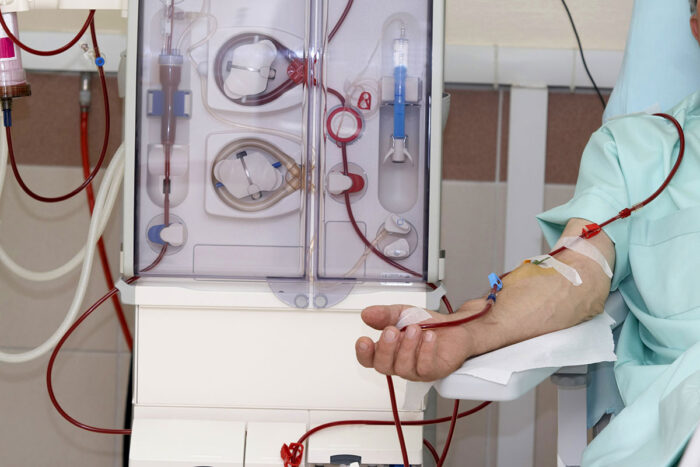Imaging agent may help gauge kidney health
Could aid in assessments of donated kidneys, ID people in early stages of disease
 Getty Images
Getty ImagesA patient in end-stage kidney disease receives dialysis while he waits for a kidney transplant. Researchers at Washington University School of Medicine in St. Louis have developed an imaging agent that could help refine assessments of kidney health, potentially salvaging some otherwise discarded kidneys.
More than 3,000 donated kidneys are discarded every year in the U.S., even as thousands of people die on kidney transplant waitlists. About a fifth of all donated kidneys — particularly those from people who are older, have metabolic or cardiovascular conditions, or have died — are deemed poor quality. Doctors and patients often refuse such kidneys rather than risk transplanting an organ that might not work.
But studies suggest that some of the vetoed kidneys might be usable. Researchers at Washington University School of Medicine in St. Louis have developed an imaging agent that could help refine assessments of kidney health, potentially salvaging some otherwise discarded kidneys.
The imaging agent, dubbed RadioCF, attaches to and illuminates each nephron in the kidney. Nephrons are tiny filters that clean waste from the blood. People with low numbers of nephrons are at risk of developing chronic kidney disease. With the aid of the imaging agent, researchers were able to count nephrons in the kidneys of living mice and in a human kidney that had been turned down for transplantation.
The study, published online in the American Journal of Physiology: Renal Physiology, opens up the possibility of developing RadioCF into an aid for evaluating donated kidneys and a clinical tool for assessing kidney health in people with diabetes, high blood pressure or other conditions that put them at risk of chronic kidney disease.
“People are born with a fixed number of nephrons, and then they lose some with age or because of injury or disease,” said senior author Kevin Bennett, PhD, an associate professor of radiology at the university’s Mallinckrodt Institute of Radiology. “The number of nephrons is thought to be correlated with risk of progression of kidney disease. I think it’s recognized that it would be useful for clinicians to know that number, but there’s no technology to measure it. This appears to be the first tool with translatable potential that can directly measure nephron number.”
Nephrons perform the core function of the kidney. Anything that damages or destroys nephrons — persistent high blood sugar or blood pressure, drugs, toxins, infection or injury — or just being born with a small complement of nephrons, impairs kidney function and puts people on the path to developing chronic kidney disease and, in severe cases, kidney failure.
Nearly 100,000 people in the U.S. have kidney failure and are waiting for transplants. All else being equal, a kidney with many nephrons would be a better candidate for transplant than one with few, but nephron number is not routinely factored into transplant decisions, the researchers said.
Bennett and colleagues previously developed a way to count nephron number using a charged protein known as cationic ferritin and MRI.
“We get beautiful maps of the nephrons with MRI, but the problem is that MRI requires a high dose of cationic ferritin, so it may be difficult to translate into clinical use in living patients,” Bennett said. “So we took the ferritin molecule and turned it into a PET agent. That allowed us to drop the dose by a factor of 1,000.”
Positron emission tomography, or PET, is a way of visualizing biological structures by detecting radiation emitted by a radioactive tag attached to a targeting molecule. To make a PET tracer for nephrons, Bennett and colleagues affixed the radioisotope Cu-64 to cationic ferritin. Along with Bennett, the research team included co-first authors Edwin Baldelomar, PhD, a postdoctoral researcher, and David Reichert, PhD, an associate professor of radiology, and co-author Kooresh Shoghi, PhD, an associate professor of radiology — all at Washington University — as well as Bennett’s research partner and co-author Jennifer Charlton, MD, a pediatric nephrologist at the University of Virginia, among others.
To assess whether RadioCF can be used to estimate nephron number in living animals, the researchers injected healthy mice with the compound. For comparison, they also injected mice carrying a mutation that reduced their nephron density by about a third. The PET signal was significantly stronger in healthy mice. For both groups of mice, the PET signal correlated with the density calculated by counting nephrons under a microscope.
The researchers also evaluated the compound in a donated kidney from a deceased 75-year-old woman that had been rejected for transplantation. They injected the kidney with RadioCF and performed a PET scan. Then, they injected it again with cationic ferritin and ran an MRI for comparison. As expected, the MRI produced more detailed data. But the two methods were closely correlated, indicating that RadioCF accurately measured the number of nephrons.
“If we could measure nephron number in people with diabetes or hypertension or something else that puts them at risk of chronic kidney disease, or in people in the early stages of kidney disease, doctors could initiate treatment early to try to preserve kidney function and reduce the chance they will develop end-stage kidney disease and require a transplant,” Bennett said.
Most people living with chronic kidney disease don’t know it because symptoms such as fatigue, reduced urination, difficulty sleeping and shortness of breath often don’t appear until the disease is advanced and the kidneys have begun to fail. The researchers are working toward a clinical trial to evaluate whether RadioCF accurately measures the number of nephrons in people.






